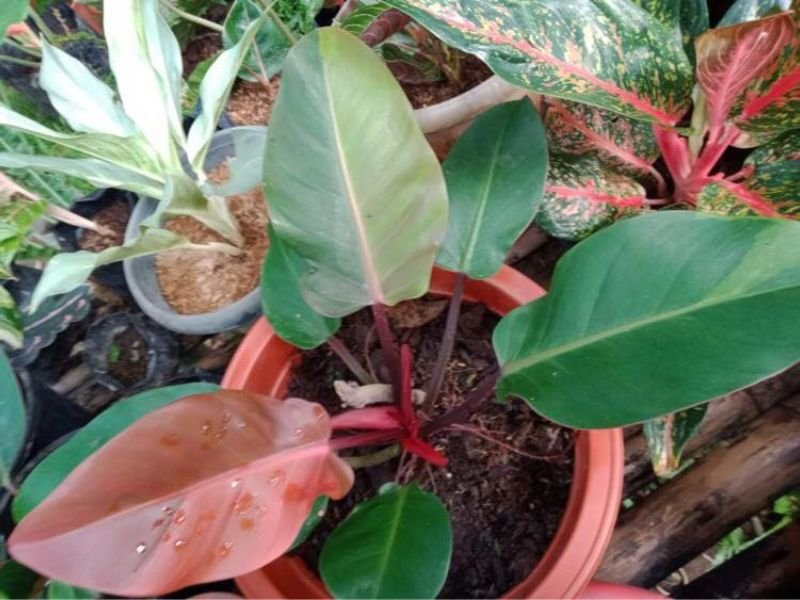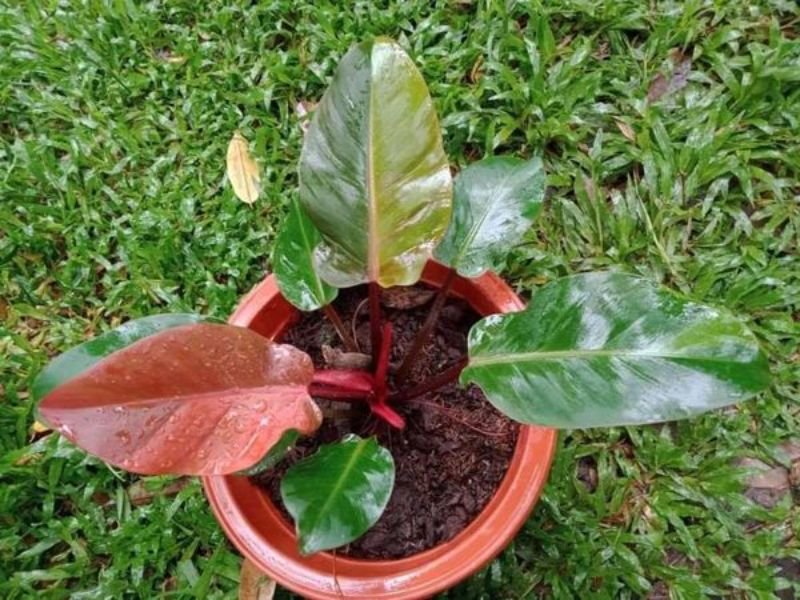Philodendron Cherry Red is a stunning plant that is known for its bright red leaves and glossy texture. This plant is a cultivar of the Philodendron genus and is a popular choice for indoor and outdoor gardens. With its climbing nature and heart-shaped leaves, Philodendron Cherry Red adds a pop of color and texture to any space.
Table of Contents
Characteristics and Description of Philodendron Cherry Red

Physical Appearance
Cherry red philodendron has a distinctive appearance, making it easily recognizable. This plant can grow to be quite large, reaching up to 6 feet in height and 3 feet in width. The leaves are heart-shaped and can reach up to 12 inches in length. The stem of Philodendron Cherry Red is thin and woody, and the plant has a climbing habit, making it a great choice for hanging baskets or trellises.
Unique Features
Philodendron Cherry Red is known for its bright red leaves, which is a unique feature among Philodendron species. The leaves are glossy and have a velvety texture, adding a touch of sophistication to any space. Additionally, the leaves have a dark green edge, which creates a striking contrast with the bright red color.
Color
Philo Red Cherry is named after its distinctive bright red leaves. This vibrant color is what sets this plant apart from other Philodendron species and is what makes it a popular choice for indoor and outdoor gardens. The color of the leaves can vary slightly depending on the light conditions, but it will always be a bold and eye-catching red.
Care Instructions for Philodendron Cherry Red

A. Light Requirements
Philodendron Cherry Red is a low-light tolerant plant, making it a great choice for those with limited or low-light conditions in their home or garden. However, it will thrive in bright, indirect light. Avoid placing it in direct sunlight as this can cause the leaves to fade or become scorched.
B. Watering
Needs Cherry Red Philodendron is a relatively low-maintenance plant when it comes to watering. It prefers to be kept evenly moist, but it is important not to overwater as this can cause root rot. Allow the top inch of soil to dry out between waterings and make sure the plant has good drainage.
C. Soil Type
Philodendron Cherry Red prefers well-draining, moist soil. A mixture of potting soil and perlite or sand works well for this plant. Make sure the pot has good drainage holes to prevent water from sitting in the soil for too long.
D. Temperature
Philodendron Cherry Red is native to the tropics, so it prefers warm and humid environments. This plant can thrive in temperatures between 60 and 90 degrees Fahrenheit, but it should be protected from cold drafts and sudden temperature changes.
E. Humidity
Philodendron Cherry Red is native to a humid environment, so it prefers high humidity levels. This plant can be misted regularly to increase humidity or placed in a bathroom or near a humidifier. Avoid placing it in a dry or air-conditioned room, as this can cause the leaves to become dry and brittle.
Troubleshooting Common Issues
Yellow Leaves
Yellow leaves on philodendron red cherry can indicate a number of issues, including over-watering, poor drainage, or a lack of nutrients. Make sure the plant is not sitting in water and check the soil to ensure good drainage. Fertilize the plant regularly to ensure it has all the necessary nutrients. To prevent yellow leaves, make sure the plant is getting enough light, water, and nutrients.
Wilting
Wilting of Philo Red Cherry can be caused by under-watering or poor drainage. Make sure the plant is getting enough water and check the soil to ensure good drainage. If the soil is dry to the touch, it is time to water the plant. To prevent wilting, make sure the soil is evenly moist but not overwatered.
Brown Tips
Brown tips on the leaves of Philodendron Cherry Red can be caused by dry air, low humidity, or a buildup of minerals in the water. Increase humidity levels by misting the plant or placing it near a humidifier. Use distilled or purified water to avoid mineral buildup. To prevent brown tips, increase humidity levels and use distilled or purified water.
Root Rot
Root rot is a common issue in philodendron red cherry and can be caused by over-watering or poor drainage. Make sure the pot has good drainage holes and allow the top inch of soil to dry out between waterings. Remove the plant from its pot and inspect the roots. If the roots are black or mushy, they have likely rotted and need to be removed. To prevent root rot, make sure the pot has good drainage and allow the top inch of soil to dry out between waterings.
Propagation Tips
A. Types of Propagation
Philodendron Cherry Red can be propagated through stem cuttings, division of offsets, or air layering.
B. Step-by-Step Guide for Each Type
- Stem Cuttings: Take a stem cutting with at least two or three leaves, dip the cut end in the rooting hormone, and plant it in moist soil. Keep the soil moist and place the cutting in bright, indirect light.
- Division of Offsets: When the plant becomes too large or crowded, gently remove it from its pot and separate the offsets. Repot each offset into its own pot with fresh, well-draining soil.
- Air Layering: Air layering is a method of propagating woody plants where a stem is partially girdled and roots are encouraged to grow from the wound. To air layer, Philodendron Cherry Red, make a cut in the stem, dust the wound with rooting hormone, wrap moist sphagnum moss around the wound, and wrap with plastic wrap to keep the moss moist.
C. Recommended Time for Propagation
The best time to propagate Philodendron Cherry Red is in the spring or summer when the plant is actively growing.
D. Key Tips for Successful Propagation
To ensure successful propagation of red cherry philodendron, keep the soil moist but not over-watered, place the cutting or division in bright, indirect light, and provide adequate humidity. Make sure to choose healthy, mature stems or offsets for propagation.
Design and Decoration

Common Uses for Philodendron Cherry Red
Philo Cherry Red is commonly used as a houseplant or in outdoor gardens as a climbing or trailing plant. Its vibrant red leaves add a pop of color to any space.
Inspiring Ideas for Home or Garden Design
- Philodendron Cherry Red can be grown in a hanging basket to create a cascading effect.
- Train the plant to climb a trellis or pole for a unique, vertical display.
- Group several plants together for a lush, tropical look in your home or garden.
Adding Philodendron Cherry Red in Interior Design
Philodendron Cherry Red can be used in a variety of interior design styles, from minimalist to bohemian. Its vibrant red leaves can add a pop of color to neutral spaces or enhance a bold, colorful room. Consider placing it in a bright, sunny window or on a shelf where it can trail down for a stunning visual effect.
Final Thoughts
Philodendron Cherry Red is a beautiful, vibrant plant that can add color and life to any space. With proper care and attention, it can thrive and bring joy to its keeper.
Care for red cherry philodendron Proper care is essential for Philodendron Cherry Red to thrive and maintain its vibrant red leaves. This includes providing the right amount of light, water, soil, temperature, and humidity.
If you’re looking for a plant that’s easy to care for and adds a pop of color to your space, Philodendron Cherry Red is a great choice. With its unique features and simple care requirements, it’s a rewarding plant to keep and enjoy. Give it a try and bring some vibrant color into your life!
FAQ
How big does Philodendron Cherry Red grow?
It can grow to be several feet tall and wide.
How fast does Philodendron Cherry Red grow?
It grows slowly to moderately, depending on the conditions.
Can Philodendron Cherry Red be grown in a terrarium?
Yes, it can be grown in a terrarium with proper care.
Is Philodendron Cherry Red toxic to pets?
Yes, Philodendron species can be toxic to pets if ingested.
Can Philodendron Cherry Red be grown outdoors?
No, it is best to keep Philodendron Cherry Red as a houseplant.
How do I fertilize Philodendron Cherry Red?
Once a month use a balanced, water-soluble fertilizer.
How do I prune Philodendron Cherry Red?
Pruning can be done by removing yellow or dead leaves and cutting back any leggy growth.
Is Philodendron Cherry Red susceptible to pests or diseases?
Yes, it can be susceptible to pests such as spider mites and mealybugs, and diseases such as root rot and leaf spot.
Can Philodendron Cherry Red be grown in low light conditions?
It prefers bright, indirect light but can tolerate low light conditions with reduced growth.
How often should I water Philodendron Cherry Red?
Water once a week, or when the top inch of soil is dry. Be careful not to over-water as this can lead to root rot.
Can Philodendron Cherry Red be grown in a hanging basket?
Yes, it can be grown in a hanging basket with proper care and support.
How do I propagate Philodendron Cherry Red?
Propagation can be done through stem cuttings or division of the root system.
How long does it take for Philodendron Cherry Red to produce new leaves?
It can take several weeks to several months for new leaves to grow, depending on the conditions.
How can I encourage more red color in my Philodendron Cherry Red?
The red color is intensified by bright, indirect light. Keep the plant in a location with plenty of bright, indirect light to encourage more red color.

Gardening is my passion and growing plants indoors has always been a stress relief for me. Grow a banana tree in my apartment once (although failed to produce bananas).






